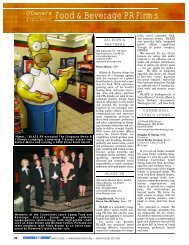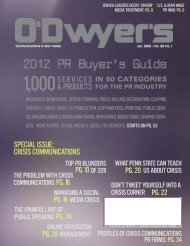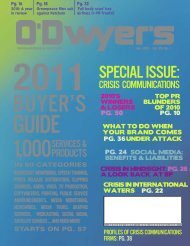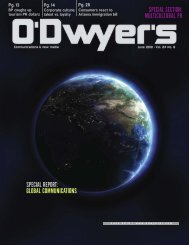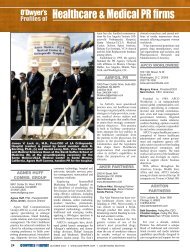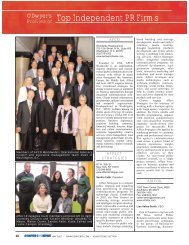PR Firm Rankings - Odwyerpr.com
PR Firm Rankings - Odwyerpr.com
PR Firm Rankings - Odwyerpr.com
You also want an ePaper? Increase the reach of your titles
YUMPU automatically turns print PDFs into web optimized ePapers that Google loves.
<strong>PR</strong> planning = social science<br />
By Fraser Seitel<br />
<strong>PR</strong> planning is a bona fide social science<br />
that distinguishes strategic <strong>PR</strong><br />
from the seat-of-the-pants practice of<br />
which many in the field are often guilty.<br />
Too often, alas, “<strong>PR</strong> planning” consists<br />
of a supervisor<br />
exhorting his troops<br />
to “Get some bodies,<br />
cameras, lights to the<br />
press conference —<br />
now!”<br />
Not a particularly<br />
thoughtful strategic<br />
process.<br />
Fraser P. Seitel has<br />
been a <strong>com</strong>munications<br />
consultant, author and<br />
teacher for 30 years. He<br />
is the author of the<br />
Prentice-Hall text, The<br />
Practice of Public<br />
Relations.<br />
More preferable —<br />
especially if you consider<br />
the practice of<br />
<strong>PR</strong>, as my friend Prof.<br />
John Doorley does, a<br />
bone fide social science<br />
— is to approach<br />
every assignment<br />
with a predetermined<br />
planning grid that considers the following<br />
10 steps.<br />
First, Background and Research.<br />
What is the <strong>PR</strong> and business situation we<br />
are addressing Where does the <strong>com</strong>pany<br />
stand in the industry What is the status of<br />
the industry What is the problem we are<br />
trying to prevent or mitigate … or the<br />
advantage we are trying to maximize<br />
Finally, what does the research show<br />
The research is critical to help us navigate<br />
to the goal we wish to reach.<br />
Second, Goal / Objectives. This is the<br />
generalized statement of what you want to<br />
ac<strong>com</strong>plish. Communication goals and<br />
objectives are often distinct from the organizational<br />
or business objectives but they<br />
must always support the organizational or<br />
business goals.<br />
Third, Strategies. A strategy is a generalized<br />
statement of the kinds of actions you<br />
will employ to achieve the objective. A<br />
strategy <strong>com</strong>prises all the tactics, and each<br />
tactic should fall into place in support of<br />
your strategies.<br />
Fourth, Tactics. A tactic is a specific<br />
action you will take or tool you will use,<br />
such as a news release, a blog, a podcast, an<br />
interview, a note to employees from the<br />
CEO, a speech, a video news release, a<br />
tweet and so on. As noted, many public<br />
relations managers like to jump straight to<br />
tactics.<br />
But as Prof. Doorley cautions, “If you<br />
don’t know where you’re going, any road<br />
will take you there.” And you may well end<br />
up in the wrong place.<br />
Fifth, Audiences / Stakeholder Groups.<br />
<strong>PR</strong> people must break down audiences into<br />
demographic or psychographic subgroups.<br />
This is particularly true in a day of splintered<br />
media and Internet sub-publics.<br />
There is no such thing as “the Congress”<br />
or “the press,” or “the employees” or the<br />
“general public.” The more “granularly” —<br />
to quote a popular business term — we<br />
define our audiences, the more likely we are<br />
to persuade them.<br />
Sixth, Messages. What messages will<br />
help us reach our audiences and ac<strong>com</strong>plish<br />
the objectives The best messages are<br />
those distinctly designed for a particular<br />
well-delineated public. What employees<br />
care most about in a particular <strong>PR</strong> situation<br />
— job security, for instance — might be<br />
different from what shareholders care most<br />
about — usually earnings.<br />
<strong>PR</strong> messaging is where the “rubber<br />
meets the road.” While most general business<br />
managers can devise strategies and<br />
objectives, few possess the <strong>com</strong>munications<br />
capability to create persuasive messages.<br />
That’s the province of the professional<br />
<strong>com</strong>municator, i.e. the <strong>PR</strong> professional.<br />
Professional Development<br />
So conceiving winning messages is a most<br />
critical stage of the planning process.<br />
Seventh, Assignments /<br />
Responsibilities. Assigning specific tasks<br />
to individuals not only specifies accountability<br />
for each phase of the project, but also<br />
gives everyone a feeling of responsibility<br />
for the project’s success.<br />
Eighth, Timeline. How long will it take<br />
to implement the strategy, carry out the various<br />
tactics and ac<strong>com</strong>plish the objectives<br />
(Planning language is important: one<br />
ac<strong>com</strong>plishes an objective; one does not<br />
ac<strong>com</strong>plish but rather, “employs” a strategy.)<br />
<strong>PR</strong> deadlines are necessary in every<br />
assignment. So, too, therefore, is setting a<br />
timeline.<br />
Ninth, Budget. In other words,”What<br />
will it cost”<br />
Tenth, Evaluation. After all is said and<br />
done, “Did we achieve the objectives —<br />
both of the <strong>com</strong>munication plan and of the<br />
business” Evaluative research is necessary<br />
to help measure what we have<br />
achieved and, if appropriate, make midcourse<br />
corrections.<br />
Public relations planning isn’t sexy, nor is<br />
it a guarantee that you won’t be yelling for<br />
the “bodies and the cameras” when the<br />
dreaded day <strong>com</strong>es for the press conference.<br />
But it does help distinguish sound and<br />
strategic <strong>PR</strong> implementation. <br />
MAY 2010 WWW.ODWYER<strong>PR</strong>.COM 57



